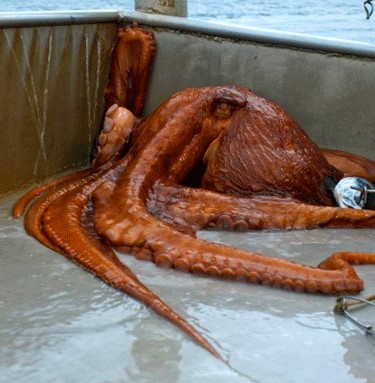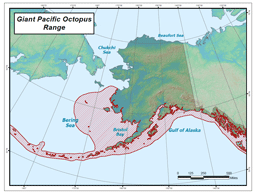Giant Pacific Octopus
(Enteroctopus dofleini)
Printer Friendly
Did You Know?
There are at eight species of octopus found in Alaskan waters; the Giant Pacific Octopus is most common.
General Description
One of about eight species of octopus found in Alaska, the Giant Pacific Octopus is the largest octopus species in the world. It is the most-often encountered octopus species in Alaska. The Giant Pacific can be pale grey to dark red depending on the use of the layered chromatophores (pigment cells) that enable it to change color. Like many octopus species E. dofleini also has the ability to change the texture of its skin allowing it to blend into structural components of the environment. The octopus has a bulbous mantle where most of its organs are located. Their parrot-like beak is made of keratin and is the only hard part of their body. An octopus can squeeze through any hole large enough to accommodate its beak - A 50-pound octopus can fit through a two-inch hole. Octopus ink is a sepia color and is used as a defense mechanism. When threatened, E. dofleini, release a jet of ink into the water creating a screen of ink to confuse and limit their predators' view.
Size
The Giant Pacific Octopus weighs 22 to 110 pounds (avg. 45-65 pounds). A 156-pound animal was recorded by Canadian researchers. They have a relatively short lifespan and achieve this weight in about five years. The adult octopus arm length can span up to 16 feet (note they are called arms, not tentacles). The suction discs on the arms are quite effective and octopus have been able to unscrew the lids of jars - from inside the jar.
Life History
The Giant Pacific Octopus spends most of its life in solitude; it seeks out a mate near the end of life. The males pass a spermatophore into the female's mantle during mating, he dies a few weeks later. About 40 days after mating, the female will find a rocky den and lay up to 100,000 eggs in long strands. The female stays with the eggs, guarding them from predators, keeping them clean, and aerated for up to six months (the time period needed to hatch). The female fasts while attending to her eggs and slowly starves, she dies about the same time the eggs hatch. At hatching the young octopus are about the size of a grain of rice and float as plankton (paralarvae) near the ocean surface for weeks or several months (water temperature is a factor) before settling on the ocean floor and developing a more octopus-like appearance. The lifespan of E. dofleini is thought to be 3-to-5-years.
Octopus seek shelter and protection in crevices, holes and "dens." Shells and debris from feeding accumulate on the sea floor outside dens and divers can sometimes locate dens by these middens.
Intelligence
Octopuses are curious and active; responding to stimulus with complex and diverse movements such as lunging at fish, patterning their actions when predators are near, and responding to the attention of others. Octopuses are the only invertebrate group named in the Cambridge Declaration on Consciousness as having the neurological substrates of consciousness. Octopus have the greatest brain-to-body-size ratio of any invertebrate. Giant Pacific octopuses are commonly kept on display at aquariums due to their size, interesting physiology and public appeal. Captivity research has helped to link feeding, prey preference, and habitat selection to behavioral responses. Identified behaviors include shooting water and moving towards caretakers, changing body texture, as well as other consistent behaviors regarding diet preference. There is evidence that captive octopus recognize individual people and treat different people differently. They have the ability to solve simple puzzles, open childproof bottles and use shells and stones as tools. They are known to escape tanks and aquariums, and also to return after forays. With more people spending time in the oceans through SCUBA diving, underwater photography, and aquarium observations, the understanding of octopus behaviors and intelligence is increasing.
Diet
The Giant Pacific Octopus is carnivorous; its diet includes shrimp, crab, scallop, clam, lobster, fish, and soft bodied prey. They have been known to scavenge larger fish and birds. They have excellent eyesight.
Range and Habitat
Giant Pacific Octopus ranges throughout temperate waters of the Pacific Ocean (ranging south from southern Baja California and north to Alaska, west to the Aleutian Islands and then south again to Japan). The Enteroctopus dolfeini occurs from the shallow subtidal to 3,280 to 4,921 feet depth in the southern regions of its range and from the intertidal to at least 328 feet in the northern regions.
Status, Trends, and Threats
The short life span combined with the reclusive nature of this species makes research difficult. Populations estimates of Giant Pacific Octopus are currently unknown in the North Pacific; however, increased popularity in the human food market and as bait for fisherman has not only increased their value as by-catch in commercial fisheries; it has also increased the number of Giant Pacific Octopus being caught across the Pacific Ocean.
Octopus are eaten by virtually everything that can catch them, including sea lions, seals, fish, birds, and people.
Fast Facts
- A 50-pound octopus can fit through a two-inch hole.
- Octopuses are sometimes called the "chameleons of the sea" due to their ability to change color and texture of their skin (seemingly disappearing).
- The adult Giant Pacific Octopus has approximately 2,140 to 2,240 suction cups on their arms, giving them a powerful grip and a sense of taste and smell.
- The Giant Pacific Octopus has eight arms, three brains and three hearts (two hearts pump blood to the gills and the third circulates blood to the rest of the body).
- The Giant Pacific Octopus is known for having blue blood due to a copper-rich protein called hemocyanin in their bloodstream.
Did You Know?
- The Giant Pacific Octopus is in the mollusk Phylum Mollusca including snails, clams, chitons; and the Class, Cephalopoda including squid, cuttlefish and nautilus.
- There are at eight species of octopus found in Alaskan waters; the Giant Pacific Octopus is most common.
- Octopus are the most intelligent mollusk; captive octopus recognize individual people and treat different people differently. They have the ability to solve simple puzzles, open childproof bottles and use shells and stones as tools.
- An octopus in a jar can unscrew the lid and open it from the inside.
Uses
The Giant Pacific Octopus is considered a delicacy and is also used as fishing bait. Octopus, like squid, collectively contribute to a 2.5-million-ton harvest in worldwide fisheries; creating interest in developing the commercial harvest in Alaska. Octopus has accounted for approximately 35,000 pounds of annual bycatch during the Lower Cook Inlet cod fishery. Octopus are generally caught using a string of pots or traps on a groundline, similar to long-line fishing. They can be caught in unbaited pots because they seek shelter in cavities.
Management
Based on the solitary nature and lack of detailed information about the Giant Pacific Octopus population; there are currently no management actions or restrictions. While they are not believed to be threatened, they are sensitive to pollutants. Learning the biology and ecology of other species of octopus may help guide future research and management decisions for the Giant Pacific Octopus.
More Resources
Alaska Sea Life Center: https://www.alaskasealife.org/aslc_resident_species/45
NOAA: https://www.fisheries.noaa.gov/alaska/science-data/octopus-research-alaska
National Geographic: https://www.nationalgeographic.com/animals/invertebrates/facts/giant-pacific-octopus
Alaska Fish and Wildlife News article - Giant Pacific Octopus: http://www.adfg.alaska.gov/index.cfm?adfg=wildlifenews.view_article&articles_id=303
Sounds Wild episode – Octopus color change: https://www.adfg.alaska.gov/index.cfm?adfg=soundswild.episode&title=Octopus%20color%20change
Sounds Wild episode – Giant Pacific Octopus:
https://www.adfg.alaska.gov/index.cfm?adfg=soundswild.episode&title=Giant%20Octopus
ADF&G Prince William Sound Octopus Guideline Harvest levels: https://www.adfg.alaska.gov/index.cfm?adfg=commercialbyareapws.pws_shellfish_octopus_harvest
ADF&G Cook Inlet Octopus Guideline Harvest levels:
https://www.adfg.alaska.gov/index.cfm?adfg=commercialbyareacookinlet.cookinlet_shellfish_octopus_harvest
Written by Evelyne Tunley-Daymude, Ph.D. (2021)
Range map ADF&G by Josh Mumm
Photos ADF&G and NOAA


